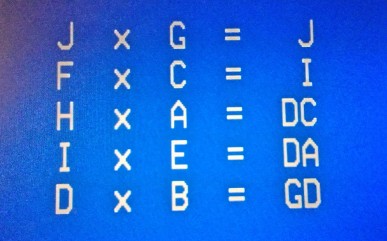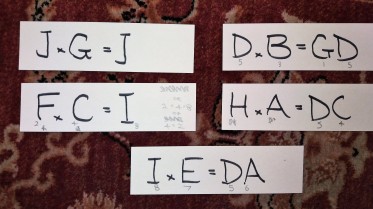I’d be grateful if you’d help me in a little experiment.
In the photo the letters A to J stand, in some order, for the digits 0 to 9. (As you’ll no doubt guess, a two-letter item stands for a number such as 23 rather than 2×3.)
The first question I’d ask you is roughly how long you needed to solve the whole set of statements and discover the unique solution. Did you see everything straight away? Five minutes? Ten? Were there any blind alleys, and fresh starts?
Secondly, you’ll want to reflect on the mathematical and reasoning skills you needed to call upon.
Thirdly, who might you see as suitable pupils for the problem?

For what it’s worth, I think it probably took me about 15 minutes, perhaps 20; I found four possibilities and had to explore each of them. It wasn’t we were working through it together that I realised there was a much better approach that avoided multiple possibilities and allows you to home in smoothly on the unambiguous solution.
And, as you’ve realised, “we” means the remarkable Amy and her partner Paddy; I’ve written before a couple of times (March 2017) about her unusually highly developed reasoning abilities. Now 55 years of teaching give me a pretty solid feeling that this isn’t a problem you dish out to your average 11-year-old (actually Amy was ten when we first me, but like me she’s had a birthday since then).
But I’ve had plenty of pupils who’ve been able to tackle this problem, and the biggest reason they can handle it is motivation. It’s one of many challenges they meet in Anita Straker’s “Martello Tower” adventure game, and by the time they’ve invested several weeks of effort they’re not going to let one more problem put them off.
Usually, however, I offer a clue or two, and my contribution with Amy and Paddy was much more limited. I did write out each of the statements onto card so they could sequence them as they wished and write on them to keep track, but otherwise

my contributions were restricted to comments like “What does that tell you?” and “What could you do next?” On completion I congratulated them, and Paddy said something to the effect that he didn’t know what I was making a fuss about, it had all seemed pretty easy!
This was our final session together, and eight weeks of working with them has reminded me yet again just how localised children’s abilities can be. Their performance in some other arithmetical problems was nothing like as advanced. In the adventure they need to identify a four-digit number using ‘more than’ / ‘less than’ clues and neither of them were great at that, and Amy was worse than Paddy. In Martello Tower they repeatedly need to use triangular numbers and neither of them ever really reached the stage where they could find TN16 without working from and earlier one like TN10 or TN12. My other pupils have almost invariably called upon the streamlined method long before the end of the adventure.
It’s not simply that some children are good at number and less so at spatial stuff, and vice versa. Amy and Paddy are able to operate a very high level in some number work, and much more mundanely at other activities even in related areas, and the difference in maturity can be quite dramatic.
I’m reminded that one year I was asked to lead the national evaluation of pupil performance in the Key Stage 2 national tests. One thing jumped out at me: for virtually every one of the hardest (level 5) questions something like 10% of the correct answers were given by children whose overall achievement was graded at below average level 3. And of course it was a different 10% each time; clearly there are a lot of Amys around, with a very jagged profile of skills across different areas of the curriculum.
Potentially this has huge consequences for the way we group and teach children, and I thought it was so important that we should be shouting it from the rooftops. But no-one else seemed at all interested, and rather to my relief the curriculum authority decided to keep the process in-house and never invited me to do the job again.
.
.
It took me 5 minutes. Noting that I spent several weeks not so long ago working through exactly this sort of problem with an extension maths class (ages about 9-11), and I probably have the thinking patterns down pat at the moment. Ask me again in 12 months when I am out of practice. It’s interesting, though, to reflect broadly on the “thinking skills” used :
(i) identify the obvious as soon as possible. (G = 1)
(ii) scan quickly through the rest of the problem to identify the next easiest entry point.
I picked D x B = 1D and then F x C = I
From these I could work out that D = 5, B = 3, I = 8, and {F,C} = {2,4}
If I am honest, I have to confess that I got lucky here, because I had decided very quickly that there was only 1 possibility for D and for B; conveniently for me, it was the correct answer. There was another possibility, which I had overlooked and only identified when I went back to check my working. It could be dismissed fairly quickly, using the information from {F,C}, but it was nevertheless an oversight in the initial solution process.
(iii) don’t be afraid to continue working with limited information (e.g. not knowing which of F and C was 2 or 4)
(iv) look for a place where you can use the new information you have.
From 8 x E = 5A, it’s clear that E = 7 and A = 6 (only possibility)
Then, from H x 6 = 5C, it’s clear that H = 9 and C = 4 (only possibility)
(v) check back to see if the new information can be used to plug any gaps
If C= 4 then F = 2
The extension group students who worked with me enjoyed these problems but found them challenging; and my focus had been simply on practising logical thinking and place value. I wish now I had asked the students to describe the mathematical thinking and reasoning skills they used. I wonder what difference that would have made.
Thanks, Gina. It’s interesting to see there are several ways to work through. My own original method used FxC=I to recognise that for I to be a single digit it had to be 6 or 8, and F and C had to be 2 and either 3 or 4 (or vice versa). That gave me four possibilities and I worked through them to find the correct pair. It wasn’t till I came to work through it with the children I hit upon a more efficient method. Many thanks for your observations.
It took me about 15-20 minutes too. I saw that J had to be zero. Then it didn’t come at first… ‘I don’t like this kind of puzzle.’ Then I saw that I had to be 6 or 8. Tried with 6, then with 8 and then it started coming into place. Then it got more satisfying.
As for reasoning, it’s partly not reasoning isn’t it? Or maybe thought processes we don’t always call reasoning. Looking round for a place to start. Dealing with frustration. Once there’s a starting point it’s finding options and eliminating them.
I think it would work well as a follow up to your envelope questions. My Y4s did well with the addition ones. Once the multiplication ones are familiar, this kind of puzzle is a next step.
I used Martello Tower back in the 80s! I’ve just been and searched, and it’s still there on the Web. I must hava
It’s interesting about the jagged profile. What would you say the implications of that are, Alan?
Terrifying! There’s the small problem of just how meaningful any test or exam results can be if every one of the hardest questions can actually be answered correctly by a good number of low-scoring children, and that this will be a different subset for every question. Why did I never think to mention this to Mike Ollerton when we worked together on an assessment project?
I was particularly pleased to use this example with Amy, as the very first statement echoes her observation about 0 and 1 in the envelope problem. But when we worked though it together there was something I didn’t see earlier when I did it on my own – using real Amy-style thinking, one of the four remaining statements must contain a 5 and hence the product must end in a 5 or 0 (and we can see none ends with a 0). The only candidate is DxB=GD, and everything falls out straight away. In all the examples of these I’ve solved I have NEVER thought of that piece of reasoning before. Thanks, Amy!
The link with the Envelope problems is closer than you think. I devised them specifically to model the Martello Tower problem in the first place. I’ve only been able to make the version of the program I downloaded work on a laptop running older versions of Windows, so I have to lug my weighty laptop into school – the laptop is older than the children – but the programme still works its magic.
“Reasoning” is the best word we’ve got. But a further trip back into the past reminds me that the very first drafts of the National Curriculum in mathematics had something like a “Personal Qualities” section.